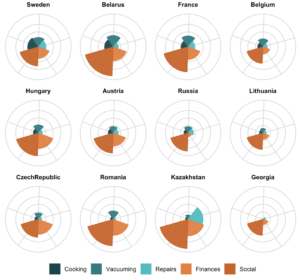In the 1950s and 1960s, families generally followed the male-breadwinner model characterized by a clear gender division of labour both in terms of paid and unpaid work. The graph below shows the percentage of women who report dividing household work equally with a partner. Equal division of labour depends heavily on the household task considered. Equal responsibility for planning social events is common with 40-80% of women reporting to share this task with her partner. Additionally, financial chores are among the tasks often divided between partners. However, other chores - such as cooking and vacuum cleaning, and performing small repairs - mostly fall on the shoulders of one of the partners: cooking and vacuum cleaning are mostly done by women, while performing small repairs is mostly done by men. Data from the GGP can help inform policies in ways to further support gender equality.
Source: GGP2020 for Belarus and Kazakhstan and GGP wave 1 for the other countries.
Countries are ranked by the proportion of women reporting dividing cooking equally with their partner.
